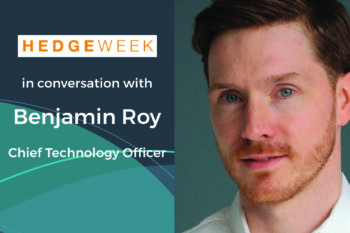This article was first published in The Hedge Fund Journal on 3rd October 2023 here.
Diversification: inside Discus and investor portfolios.
CFM Discus has received The Hedge Fund Journal’s CTA and Discretionary Trader performance award* for best risk adjusted returns over 2 and 5 years ending in December 2022 in the systematic short-term trader (AUM > $500 million) category. The awards were powered by data provided by Preqin and announced on 17 May 2023.
A net return of 35.3% in 2022 was the third strongest since the program started in 1991, only surpassed by returns of 64.7% in 1991 and 44.8% in 1997, though the strategy has changed beyond recognition since the 1990s.
Returns have come from directional long, short and relative value trading of a universe of more than one hundred liquid instruments in equity indices, credit indices, long term interest rates, short term interest rates, developed and emerging market currencies, and commodities including energy, metals and agricultural. Some models are universal, and others apply to specific asset classes.
Though a long allocation to commodities had some portfolio value in 2022, in general more traditional long only portfolio diversification failed investors in 2022, when equities and bonds dropped in tandem and even some alternatives – such as private equity – have proved to be rather correlated with equities, as CFM explained in a February 2023 article: “Why your ‘Private Markets’ strategy is really just one big equities play”. The apparent diversification benefits of some private markets strategies can be an ephemeral phenomenon partly based on the “stale pricing” problem: being valued less frequently means that they just take time to catch up with public market valuations, and discounted secondary market valuations for private equity deals and some listed closed end funds suggest that some investors are sceptical about some valuations of illiquid assets.
Many investors are looking at liquid alternatives for stronger and more robust sources of returns and diversification in a climate of economic, financial market and geopolitical uncertainty. CFM Discus has historically shown very low correlations to equities and bonds, of minus 0.10 and plus 0.11 respectively, which are within the plus/minus 0.20 range generally deemed to be statistically insignificant.
A multi-strategy systematic approach can extract alpha (and some tactical beta) from a myriad of data types, trade signals and analytical models. Discus, CFM’s oldest strategy run since 1991, now has 200 alpha engines or predictors. They use technical, fundamental and alternative data, and trade both directionally and increasingly also relative value spreads.
“All of these flavours and ideas help to make it an all-weather strategy,” says Yves Lemperiere, Head of Alpha Predictor Research at CFM. There has been a long and ongoing journey of evolution to find more dimensions of alpha generation. “The roadmap is to try and create 30 new models per year, potentially growing the total to as many as 400 within 5 years. We would love to have 400-500 predictors in 5 to 6 years’ time. This could increase the target Sharpe ratio to 1.2 and it could also increase capacity,” says Lemperiere.
Discus currently targets a Sharpe ratio of 0.8 through a full cycle, but far exceeded that in 2022, which was an exceptional year as all “clusters” produced positive returns: technical, fundamental, machine learning and data-driven strategies were all positive. Discus has maintained the momentum in 2023 and is up 13.7% YTD as at the end of August 2023. This performance is even more remarkable when correlations between the eight clusters average only around 0.15.
Decoupling from trend
Though 2022 was conducive to trend following and Discus can selectively and tactically trade some trends, this was far from the primary return driver. Discus started as a trend follower in the 1990s, but for some years the program has been de-coupling from other CTAs and demonstrating a progressively lower correlation to trend followers. For instance, Discus held steady amid the mini-banking crisis and bond bounce in March 2023, which was the worst month in many years for trend-following CTAs, and Discus was positive in July 2022 when trend strategies saw a setback. The growing suite of relative value models performed well in these months. Looking further back to 2018 Discus also profited in what was a difficult year for many trend followers.
This declining trend correlation is no accident. There is a general objective to avoid more generic factors, though CFM does offer pure play exposure to its proprietary trend models in other products, and there are more specific constraints on trend: “New predictor signals must satisfy multiple criteria including a 15% ceiling on their correlation with trend following. The global macro cluster sleeve of Discus is now larger than the trend and contrarian cluster,” says Lemperiere.
Accelerating predictor additions
The pace of diversification is accelerating, with no less than 50 new predictors added to the program over the past 18 months, and a record 34 in 2022, net of predictor retirements. Though models are sometimes permanently retired, in most cases the automated calibration procedures handle the rebalancing and reweighting of allocations. “We have seen an explosion of predictor creation, really driven by data,” says Lemperiere.
Relative value
Relative value models are more unusual in the mainly directional quant space but are very sought after. “Most of the new predictors are relative value because we expect them to generate higher Sharpe ratios,” says Lemperiere. Relative value also explains most of the leverage in Discus, though its volatility has stayed close to the 14% target; there is also a 1.5x levered share class targeting 21% volatility.
Use cases for machine learning
Machine learning is being applied from multiple angles and using different methodologies and approaches. “10% of what we do is hard core, price-based machine learning. 10% is just new alternative data sources for some alpha. And the remaining 80% is a blend,” says Lemperiere.
“Purely technical, price-based machine learning has moved into deep learning techniques. It is difficult to get them working right, but we see a really high Sharpe ratio,” he adds.
Machine learning techniques also interrogate order books and a vast proprietary database of trades to optimize trade execution and market impact. CFM trades over $100 billion a year and has direct market access to over 100 exchanges and venues.
Machine learning is also being used on the natural language processing (NLP) side. Applying NLP to financial market prediction requires some carefully nuanced distinctions. “In single stocks it is usually clear if news sentiment is bullish or bearish. But in futures markets it is trickier to distinguish between a description of past price action and an opinion on whether news is bullish or bearish. The context of the comment needs to be carefully qualified,” reveals Lemperiere.
CFM has access to ChatGPT within the firm, and it is useful as a search engine, but it is not actually used for models. “Large language models need to be used with caution, allowing for “the fairness problem” and “entity biases”, which can lead to prejudices. All models have been trained over a certain period and their biases need to be measured and adjusted for,” explains Lemperiere.
Philosophically, CFM is not wedded to a single machine learning paradigm. The manager uses a blend of supervised machine learning techniques (including regressions and decision trees); unsupervised techniques (including clustering and dimensionality reduction) and reinforcement learning techniques (including neural networks and natural language processing).
Yet in many cases, neural networks are not actually needed. “The challenge is more to rely on robust methods, using more data science than deep machine learning,” points out Lemperiere.
Growing data libraries and new datasets
Since 2016 CFM has held the Big Data Science Chair at France’s prestigious Ecole Normale Superieure, and Discus has spent decades broadening out the types and volume of data it uses, adding fundamental data in 2005, and alternative satellite data in 2019. The in-house data libraries and catalogues keep on growing with terabytes of technical, fundamental and alternative data collected each day. The data budget rose by 25% in 2022 and will increase by 15% this year. “There are still a lot of datasets we have not yet looked at. More precision will lead to more sophisticated features and opens the way to more complicated things,” says Lemperiere.
Data types include news, text, analysts forecasts and fundamental data, which may be applied to indices, interest rates, or currencies, and inflation prediction, which regularly causes large surprises for equity markets but not for CFM: “We are pretty good at forecasting inflation using daily nowcasting well ahead. The CPI is just one construction with different weightings. We would use different baskets to predict consumption or indices,” says Lemperiere.
New data sources include bond issuance and credit card data. The credit card data can be very granular in terms of identifying spend at specific retailers (even if it is naturally anonymised in terms of the individuals’ spending).
Supply chain data is being researched at both top-down country level and from more bottom-up company angles. Discus also draws on some ESG research that is more relevant for the statistical arbitrage strategy that trades single stocks, though this sustainability research also overlaps with supply chain analysis. This is a good example of lateral thinking and communication within the firm.
Alternative data has come into its own in 2021 and 2022. “Research streams include web scraping for inflation nowcasting, NLP, forecasting commodities and global macro supply/demand analysis,” says Lemperiere. All of these data types can be blended into composite signals.
Growing collaborative team
The growing data team mix and match datasets, crossing different sorts of data. The research team has almost doubled from 50 to 100 people, with Paris being the main hub and New York also expanding with 20 hired in 2022 and 20 in 2023. A separate data science team is also growing, with PhD data scientists, statisticians and economists. There are 136 staff in technology, which spans the prediction area that Lemperiere leads, as well as portfolio management, execution, data, infrastructure and networks.
“Since 80% of the research is data driven, we pair researchers with data scientists. Collaboration is deeply embedded in the DNA of the company, and that is our big difference compared with the siloed pod platforms. We leverage heavy lifting on natural sciences, NLP, equities, futures, options and working over different timescales,” says Lemperiere.
Scalability and capacity
Some of these machine learning models, and shorter-term models, have limited capacity. For Discus, trading timeframes range from “short term” defined as 3-7 days, to “medium term” at 1-4 weeks and “long term” at 1 month. The faster models are less scalable, though the average holding period remains around 20-25 days. The medium and long-term systematic macro models can also be accessed directly through CFM’s Systematic Global Macro program launched in 2020, which has capacity to grow into the billions.
Discus has assets of $3.8 billion as of July 2023. It has an estimated $700-800 million of capacity, including $400 million on a standalone basis and the same for the Stratus sub-allocation to Discus. The Discus program is, and remains today, one of the building blocks of CFM’s multi-strategy quantitative program, Stratus, from its beginning in 2003. Stratus runs EUR 9 billion of which EUR 3 billion is in Discus, and some headroom is allowed for this sleeve to grow through performance; Stratus is currently closed. Firm assets were $11.4 billion as of July 2023.
Capacity is of course a moving target as innovation adds more predictors, and Lemperiere is confident about the opportunity set.
DISCLAIMER
Any description or information involving investment process or allocations is provided for illustration purposes only. There can be no assurance that these statements are or will prove to be accurate or complete in any way. This article does not constitute an offer or solicitation to subscribe for any security or interest.
* CFM paid a marketing fee to promote the award which includes this article written by THFJ.



